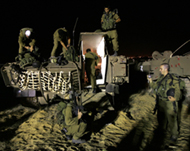Gaza hopes fade after withdrawal
One year after Israel’s pull out from the Gaza strip, the mood in Palestine is one of crushed hopes as restrictions continue to hamper development of the area and limit Palestinian ambition.

“We had withdrawal, but we don’t have freedom. It is now clear, one year after the departure of Israeli forces that the occupation is continuing,” Hani Habib, a journalist and political analyst, told AFP.
Israel still maintains control of Gaza’s territorial waters and airspace. Military checkpoints hamper freedom of movement of people and goods inside the Palestinian territory.
Israel regularly closes the terminal at Rafah – the only gateway to the outside world from the Palestinian territories without going through Israel – since Hamas won the parliamentary elections earlier this year.
“Today Gaza Strip is like a giant prison where it is impossible to leave or enter without Israeli authorisation,” Younes-al Jrau, a lawyer and rights activist, told AFP.
Fledging hope
On August 15, 2005, Israel began withdrawing 8,000 Jewish settlers and thousands of troops from the impoverished strip of land.
The historic pull out was the beginning of the end of a 38-year-occupation of the area by Israel.
|
“The economic situation is very dark. Palestinian workers can’t travel to Israel and government employees aren’t paid” |
At the time hopeful Palestinians saw this as a step towards taking back their future.
Today, feelings have changed.
“Many Palestinians hoped Gaza would become the embryo for an independent Palestinian state, but this hope has disappeared because of Palestinian leaders’ inability to build a state and continued Israeli offensives,” said Habib.
Economic sanctions which have been imposed on the Palestinian government since they came to power in January 2006 have worsened the economic situation.
“The economic situation is very dark. Palestinian workers can’t travel to Israel, government employees aren’t paid, while the Gaza Strip’s economic potential is very weak without any natural resources or industry,” Jaru said.
The World Bank estimates that unemployment is at around 45 percent and that two-thirds of the Gaza Strip lives under the poverty line, earning less than $2-a-day.
Around some 900,000 of the Palestinian population are refugees, who were expelled from their homes after the creation of Israel in 1948. Half of those live in eight camps managed by the UN.
Mending bridges
The ruling party Hamas executed an historic shift in policy on June 27 and agreed to a Palestinian statehood initiative that would implicity recognise Israel’s right to exist.
The day after this shift in policy, Israel launched a ground and air offensive into southern Gaza. A Palestinian militant group who was holding a West Bank settler threatened to kill their hostage if Israel did not halt its incursion. The settler was later found dead.
 |
|
Isreali soldiers prepare for ground |
Two days later Israel extended its military offensive to the West Bank, detaining at least 64 Hamas members, including a third of the Palestinian cabinet and a large number of lawmakers.
Violence escalated between Israel and Palestine just 12 days after Israeli prime minister Ehud Olmert’s Kadima party won Israel’s general election on March 28, on a platform of unilaterally fixing Israel’s broders with Palestine by 2010.
An explosion on a Gaza Strip beach killed eight Palestinians, including three children and both their parents on June 9.
Further air strikes by Israel killed two Palestinian activists and nine civilians, two of them children.
Palestinian militants attacked an Israeli military checkpoint killing two soldiers and capturing a third.
The death toll in five years of Israel-Palestine violence reached the 5,000 mark in April.
Lasting peace
Habib said that the Palestinian Authority has not “managed to take matters in hand since the settlers’ departure, letting corruption spread and the security situation deteriorate,” with clashes between Hamas and rival Fatah supporters in May killing 10.
A survey published last September showed that 84 percent of Palestinians considered the Israeli pullout “a victory for the armed resistance”.
“The withdrawal of Israeli forces was claimed as a victory by armed Palestinian groups, increasing their popularity and allowing the victory of Hamas in general elections in January,” Habib said.
|
“Gaza’s post-withdrawal predicament could be an ominous warning ahead of Prime Minister Ehud Olmert’s unilateral plan to withdraw from the occupied West Bank” |
“Gaza’s post-withdrawal predicament could be an ominous warning ahead of Olmert’s unilateral plan to withdraw from the occupied West Bank,” Habib said.
The Israeli government’s aim is to finalise its eastern border largely along the line of its security barrier, which encroaches heavily on Palestinian land.
“The experience of Israel’s Gaza pullout, what with Israel’s continued control of Palestinian territory, is the best example of how Olmert’s plan for finalising the frontier will be implemented,” Habib said.